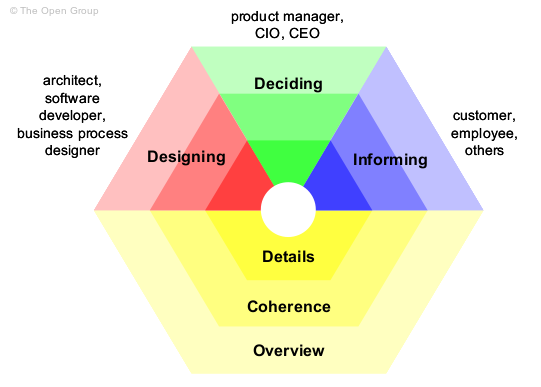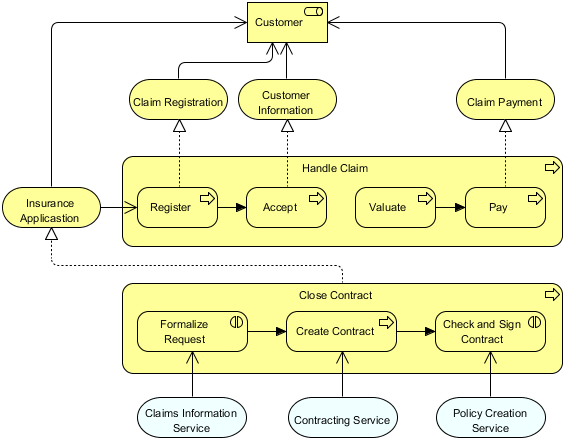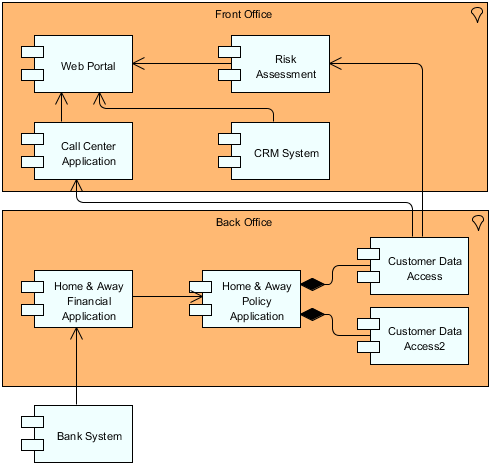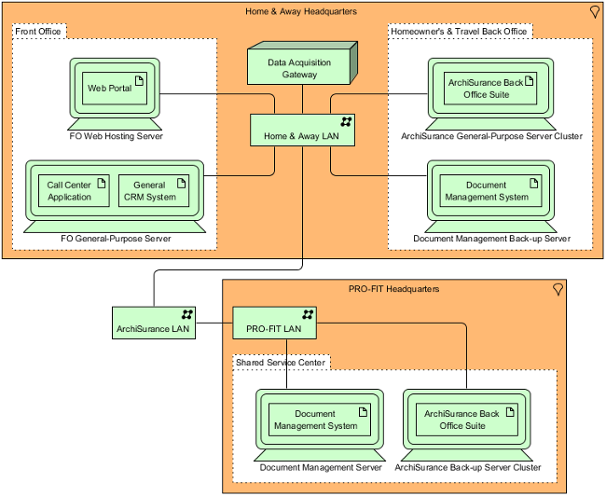Introduction
ArchiMate viewpoints are categorized into four main groups based on their purpose and content, facilitating tailored architectural representations for different stakeholders. This comprehensive guide explores each category in detail, providing numerous examples to illustrate how these viewpoints can be effectively used in enterprise architecture.

1. Designing Viewpoints
Purpose
Designing viewpoints support the design and development of the architecture. They focus on how various components fit together and interact, providing a detailed blueprint for architects and developers.
Examples
Business Process Cooperation Viewpoint
- Purpose: Illustrates how business processes interact and cooperate with each other.
- Example: In an e-commerce platform, this viewpoint can show how the order processing, payment processing, and shipping processes work together to fulfill customer orders.
- Components: Business processes, business actors, business events, and business services.

Application Cooperation Viewpoint

- Purpose: Depicts how applications interact and cooperate to support business processes.
- Example: In a banking system, this viewpoint can illustrate how the customer relationship management (CRM) system, loan processing system, and accounting system work together to manage customer accounts and transactions.
- Components: Application components, application services, and application interactions.
Technology Cooperation Viewpoint

- Purpose: Shows how technology components interact and cooperate to support applications.
- Example: In a data center, this viewpoint can depict how servers, storage systems, and network devices work together to support the IT infrastructure.
- Components: Technology components, technology services, and technology interactions.
Application Structure Viewpoint
- Purpose: Focuses on the structure of applications and their components.
- Example: In a software development project, this viewpoint can illustrate the architecture of a microservices application, showing how different microservices interact.
- Components: Application components, application functions, and application interactions.
Technology Structure Viewpoint
- Purpose: Illustrates the structure of technology components and their relationships.
- Example: In a cloud infrastructure, this viewpoint can show how virtual machines, containers, and storage systems are organized and interact.
- Components: Technology components, technology functions, and technology interactions.
2. Deciding Viewpoints
Purpose
Deciding viewpoints assist managers and decision-makers by providing insights necessary for informed decision-making. They focus on cross-domain architecture relationships and analytical techniques.
Examples
Implementation and Deployment Viewpoint
- Purpose: Provides a roadmap for implementing and deploying architectural changes.
- Example: In a company undergoing digital transformation, this viewpoint can outline the steps and timelines for transitioning from legacy systems to new technologies.
- Components: Implementation events, deployment units, and technology services.
Goal Realization Viewpoint
- Purpose: Shows how architectural components contribute to achieving organizational goals.
- Example: In a healthcare organization, this viewpoint can illustrate how the implementation of an electronic health record (EHR) system helps achieve the goal of improving patient care.
- Components: Goals, requirements, and business services.
Migration Planning Viewpoint
- Purpose: Provides a detailed plan for migrating from the current to the target architecture.
- Example: In a merger and acquisition scenario, this viewpoint can outline the migration plan for integrating the IT systems of the acquired company into the existing infrastructure.
- Components: Migration phases, migration activities, and dependencies.
Risk Analysis Viewpoint
- Purpose: Assesses potential risks and their impacts on the architecture.
- Example: In a financial institution, this viewpoint can identify risks associated with implementing a new trading platform, such as data security and system integration issues.
- Components: Risks, risk impacts, and risk mitigation strategies.
Gap Analysis Viewpoint
- Purpose: Identifies gaps between the current and target architectures.
- Example: In a retail company, this viewpoint can highlight the differences between the current inventory management system and the desired future state, identifying areas that need improvement.
- Components: Current architecture components, target architecture components, and gaps.
3. Informing Viewpoints
Purpose
Informing viewpoints aim to provide general information and understanding of the architecture to a broader audience. They help stakeholders grasp the overall architecture without delving into intricate details.
Examples
Organization Viewpoint
- Purpose: Provides an overview of the organizational structure and its components.
- Example: In a multinational corporation, this viewpoint can illustrate the organizational hierarchy, including departments, roles, and responsibilities.
- Components: Business actors, business roles, and business functions.
Capability Map Viewpoint
- Purpose: Shows the capabilities of the organization and how they are supported by the architecture.
- Example: In a manufacturing company, this viewpoint can illustrate the capabilities required for production, such as supply chain management, quality control, and logistics.
- Components: Capabilities, supporting architecture components, and capability dependencies.
Value Stream Viewpoint
- Purpose: Illustrates the value streams within the organization, highlighting how various components contribute to delivering value to customers.
- Example: In an e-commerce company, this viewpoint can show how the order processing, inventory management, and customer service processes contribute to delivering value to customers.
- Components: Value streams, supporting architecture components, and value contributions.
Stakeholder Viewpoint
- Purpose: Provides an overview of the architecture tailored to the interests and concerns of specific stakeholders.
- Example: In a software development company, this viewpoint can present the architecture in a way that highlights the benefits and impacts for different stakeholders, such as developers, project managers, and end-users.
- Components: Stakeholder concerns, architecture components, and stakeholder impacts.
Product Viewpoint
- Purpose: Focuses on the products and services offered by the organization and how they are supported by the architecture.
- Example: In a telecommunications company, this viewpoint can illustrate the products and services offered, such as mobile plans, internet services, and customer support.
- Components: Products, services, and supporting architecture components.
4. Custom Viewpoints
Purpose
Custom viewpoints allow organizations to create tailored representations of the architecture to address specific stakeholder concerns or project requirements. They provide flexibility in how architecture is represented.
Examples
Project-Specific Viewpoint
- Purpose: Tailored to the needs of a particular project, highlighting relevant components and relationships.
- Example: In a project to implement a new customer relationship management (CRM) system, this viewpoint can focus on the components and interactions specific to the CRM implementation.
- Components: Project-specific architecture components, project goals, and project dependencies.
Department-Specific Viewpoint
- Purpose: Focuses on the architecture components and interactions relevant to a specific department within the organization.
- Example: In a marketing department, this viewpoint can illustrate the components and interactions specific to marketing campaigns, customer analytics, and social media management.
- Components: Department-specific architecture components, department goals, and department dependencies.
Compliance Viewpoint
- Purpose: Addresses regulatory and compliance requirements, showing how the architecture adheres to specific standards and regulations.
- Example: In a healthcare organization, this viewpoint can illustrate how the architecture complies with HIPAA regulations for data privacy and security.
- Components: Compliance requirements, regulatory standards, and architecture components.
Security Viewpoint
- Purpose: Focuses on the security aspects of the architecture, highlighting security measures and controls.
- Example: In a financial institution, this viewpoint can illustrate the security measures in place to protect customer data and financial transactions.
- Components: Security measures, security controls, and architecture components.
Performance Viewpoint
- Purpose: Focuses on the performance aspects of the architecture, highlighting performance metrics and optimization strategies.
- Example: In an e-commerce platform, this viewpoint can illustrate the performance metrics and optimization strategies for ensuring fast and reliable order processing.
- Components: Performance metrics, optimization strategies, and architecture components.
Conclusion
These categories help architects select appropriate viewpoints based on stakeholder needs, ensuring that architectural representations are relevant, focused, and comprehensible. By utilizing these structured viewpoints, organizations can enhance communication and collaboration across different levels of their enterprise architecture. This comprehensive approach ensures that both technical and non-technical stakeholders can understand and contribute to the architectural design process, leading to better decision-making and alignment with organizational goals.
ArchiMate Viewpoint References
-
Full ArchiMate Viewpoints Guide (Examples Included)
- URL: Full ArchiMate Viewpoints Guide (Examples Included)
- Description: This guide provides a comprehensive overview of ArchiMate viewpoints, including 23 official example viewpoints with clear diagram examples and explanations. It is written by a certified ArchiMate tool vendor and supports all ArchiMate 3 vocabulary, notation, syntax, and semantics11.
-
ArchiMate Viewpoint Guide – Information Structure Viewpoint
- URL: ArchiMate Viewpoint Guide – Information Structure Viewpoint
- Description: This guide explains the Information Structure Viewpoint in detail, providing a table that describes the viewpoint and a figure showing an ArchiMate diagram created under this viewpoint. It also includes instructions on how to open the viewpoint tab in Visual Paradigm12.
-
ArchiMate Viewpoint: Technology Viewpoint – Visual Paradigm
- URL: ArchiMate Viewpoint: Technology Viewpoint – Visual Paradigm
- Description: This article describes the Technology Viewpoint in detail and provides a figure showing an ArchiMate diagram created under this viewpoint. It also includes instructions on how to select the Technology Viewpoint in Visual Paradigm13.
-
Unlocking the Power of ArchiMate Viewpoints in Enterprise Architecture: Enhancing Clarity, Relevance, and Alignment – Visual Paradigm Guides
- URL: Unlocking the Power of ArchiMate Viewpoints in Enterprise Architecture: Enhancing Clarity, Relevance, and Alignment – Visual Paradigm Guides
- Description: This guide explains the importance of ArchiMate viewpoints in enterprise architecture, highlighting how they enhance clarity, relevance, and alignment. It discusses the predefined perspectives or templates that ArchiMate viewpoints provide and how they address specific stakeholder concerns14.
-
Visual Paradigm – Full ArchiMate Viewpoints Guide (Examples Included) – ArchiMate Resources for FREE
- URL: Visual Paradigm – Full ArchiMate Viewpoints Guide (Examples Included) – ArchiMate Resources for FREE
- Description: This guide covers all 23 ArchiMate viewpoints with clear descriptions and diagram examples for each. It emphasizes the importance of viewpoints in ArchiMate and how they help model specific aspects of an enterprise architecture15.
-
Understanding ArchiMate Viewpoints Mechanism
- URL: Understanding ArchiMate Viewpoints Mechanism
- Description: This guide explains the ArchiMate viewpoints mechanism, including how to draw an ArchiMate viewpoint diagram step-by-step and how to define your own viewpoint. It also discusses the importance of viewpoints in addressing stakeholder concerns16.
-
ArchiMate Viewpoint: Stakeholder Viewpoint – Visual Paradigm
- URL: ArchiMate Viewpoint: Stakeholder Viewpoint – Visual Paradigm
- Description: This article describes the Stakeholder Viewpoint in detail and provides a figure showing an ArchiMate diagram created under this viewpoint. It also includes instructions on how to select the Stakeholder Viewpoint in Visual Paradigm17.
-
ArchiMate Viewpoint Guide – Project Viewpoint
- URL: ArchiMate Viewpoint Guide – Project Viewpoint
- Description: This guide explains the Project Viewpoint in detail, providing a table that describes the viewpoint and a figure showing an ArchiMate diagram created under this viewpoint. It also includes instructions on how to open the viewpoint tab in Visual Paradigm18.
-
ArchiMate Viewpoint: Project Viewpoint – Visual Paradigm
- URL: ArchiMate Viewpoint: Project Viewpoint – Visual Paradigm
- Description: This article describes the Project Viewpoint in detail and provides a figure showing an ArchiMate diagram created under this viewpoint. It also includes instructions on how to select the Project Viewpoint in Visual Paradigm19.
-
ArchiMate Viewpoint: Goal Realization Viewpoint – Visual Paradigm
- URL: ArchiMate Viewpoint: Goal Realization Viewpoint – Visual Paradigm
- Description: This article describes the Goal Realization Viewpoint in detail and provides a figure showing an ArchiMate diagram created under this viewpoint. It also includes instructions on how to select the Goal Realization Viewpoint in Visual Paradigm20.
These references provide a comprehensive overview of ArchiMate viewpoints, their importance, and how to use them effectively in enterprise architecture modeling.